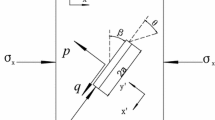Abstract
A bedding plane effect occurs when hydraulic fractures encounter the bedding plane. True triaxial hydraulic fracturing experiments were conducted with test blocks containing bedding planes. The effects of bedding plane properties and stress state on fracture propagation were analyzed. When hydraulic fracture encounters the bedding plane in sedimentary stratum, it usually propagates along the bedding plane at first. When the hydraulic pressure increases to a critical value in the direction of main hydraulic fracture, the main hydraulic fracture continues propagating along the original direction. The length of the long axial of the hydraulic fracture propagating along the bedding plane is greater than the length of the main hydraulic fracture before penetrating the bedding plane, and both of them are greater than the length of the main hydraulic fracture after penetrating the bedding plane. Three-dimensional propagation models were established. Three propagation forms of hydraulic fractures existed when encountering bedding planes: (1) propagation along the bedding plane; (2) initial propagation along the bedding plane followed by penetration of the bedding plane and propagation along the principal direction; and (3) direct penetration of the bedding plane and propagation along the principal direction.
















Similar content being viewed by others
References
Anderson GD (1981) Effects of friction on hydraulic fracture growth near unbonded interfaces in rocks. Soc Pet Eng J 21:21–29
Biot MA, Medlin WL, Masse L (1983) Fracture penetration through an interface. Soc Pet Eng J 23:857–869
Blair SC, Thorpe RK, Heuze FE et al (1989) Laboratory observations of the effect of geological discontinuities on hydrofracture propagation. In: Proceedings of the 30th US symposium on rock mechanics, Morgantown
Blanton TL (1982) An experimental study of interaction between hydraulically induced and pre-existing fractures. In: Proceedings of SPE unconventional gas recovery symposium, Society of Petroleum Engineers
Blanton TL (1986) Propagation of hydraulically and dynamically induced fractures in naturally fractured reservoirs. In: Proceedings of SPE unconventional gas technology symposium, Society of Petroleum Engineers
Cheng QY (2012) Research on permeability improvement and methane driven effect of hydraulic fracturing for low permeability coal seam. Ph.D. thesis, China University of Mining and Technology
Cheng W, Jin Y, Chen M et al (2014) A criterion for identifying hydraulic fractures crossing natural fractures in 3D space. Pet Explor Dev 41:1–6
Cleary MP (1980) Analysis of mechanics and procedures for producing favourable shapes of hydraulic fractures. In: SPE annual technical conference and exhibition, Society of Petroleum Engineers
Daneshy AA (1978) Hydraulic fracture propagation in layered formations. Soc Pet Eng J 18:33–41
Fisher MK, Warpinski NR (2012) Hydraulic-fracture-height growth: real data. Spe Prod Oper 27(1):8–19
Gu H, Weng X, Lund JB et al (2011) Hydraulic fracture crossing natural fracture at nonorthogonal angles: a criterion, its validation and applications. In: Proceedings of SPE hydraulic fracturing technology conference, Society of Petroleum Engineers
Guo T, Zhang S, Qu Z et al (2014) Experimental study of hydraulic fracturing for shale by stimulated reservoir volume. Fuel 128(14):373–380
Huang BX, Liu CY, Fu JH, Guan H (2011) Hydraulic fracturing after water pressure control blasting for increased fracturing. Int J Rock Mech Min Sci 48:976–983
Huang BX, Li PF, Ma J, Chen SL (2014) Experimental investigation on the basic law of hydraulic fracturing after water pressure control blasting. Rock Mech Rock Eng 47:1321–1334
Rutledge J, Yu X, Leaney S et al (2014) Microseismic shearing generated by fringe cracks and bedding-plane slip: Seg Technical Program Expanded, C
Suarez-Rivera R, Burghardt J, Stanchits S et al (2013) Understanding the effect of rock fabric on fracture complexity for improving completion design and well performance. In: SPE international petroleum technology conference, Society of Petroleum Engineers, C
Tada H, Paris PC, Irwin GR (1973) The stress analysis of cracks handbook. Del Research Corporation, Hellertown
Teufel LW, Clark JA (1984) Hydraulic fracture propagation in layered rock: experimental studies of fracture containment. Soc Pet Eng J 24:19–32
Thiercelin MJ, Roegiers JC, Boone TJ et al (1987) An investigation of the material parameters that govern the behavior of fractures approaching rock interfaces. In: Proceedings of 6th ISRM congress, international society for rock mechanics
Warpinski NR, Schmidt RA, Northrop DA (1980) In-situ stresses: the predominant influence on hydraulic fracture containment. J Pet Technol 34:653–664
Warpinski NR, Clark JA, Schmidt RA et al (1982) Laboratory investigation on the-effect of in situ stresses on hydraulic fracture containment. Soc Pet Eng J 22:333–340
Wei F, Ames BC, Bunger AP et al (2016) Impact of partially cemented and non-persistent natural fractures on hydraulic fracture propagation. Rock Mech Rock Eng 49(11):4519–4526
Weng XW (2015) Modeling of complex hydraulic fractures in naturally fractured formation. J Unconv Oil Gas Resour 9:114–135
Zhao HF, Chen M (2010) Extending behavior of hydraulic fracture when reaching formation interface. J Pet Sci Eng 74:26–30
Zhou J, Chen M, Jin Y et al (2008) Analysis of fracture propagation behavior and fracture geometry using a triaxial fracturing system in naturally fractured reservoirs. Int J Rock Mech Min Sci 45:1143–1152
Zhou J, Jin Y, Chen M (2010) Experimental investigation of hydraulic fracturing in random naturally fractured blocks. Int J Rock Mech Min Sci 47:1193–1199
Zou Y, Zhang S, Tong Z et al (2016) Experimental investigation into hydraulic fracture network propagation in gas shales using CT scanning technology. Rock Mech Rock Eng 49(1):1–13
Acknowledgements
Financial support for this work, provided by the National Science Fund for Excellent Young Scholars (No. 51522406), the Fundamental Research Funds for the Central Universities (China University of Mining and Technology) (No. 2014YC03) and the Priority Academic Program Development of Jiangsu Higher Education Institutions, is gratefully acknowledged.
Author information
Authors and Affiliations
Corresponding author
Rights and permissions
About this article
Cite this article
Huang, B., Liu, J. Experimental Investigation of the Effect of Bedding Planes on Hydraulic Fracturing Under True Triaxial Stress. Rock Mech Rock Eng 50, 2627–2643 (2017). https://doi.org/10.1007/s00603-017-1261-8
Received:
Accepted:
Published:
Issue Date:
DOI: https://doi.org/10.1007/s00603-017-1261-8




